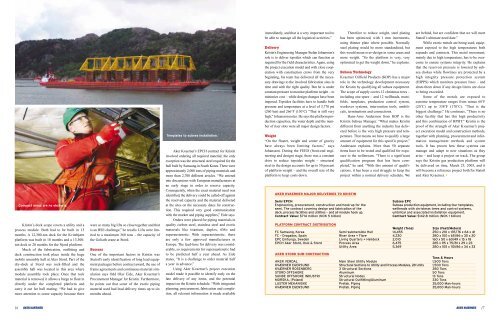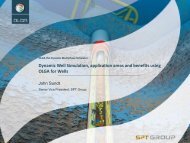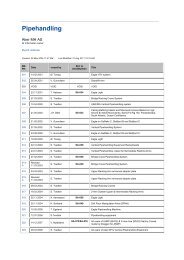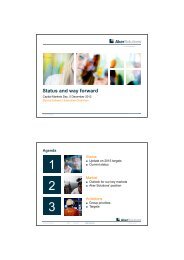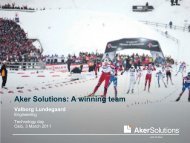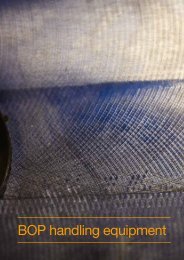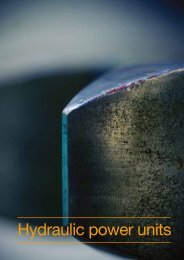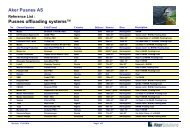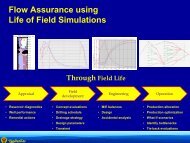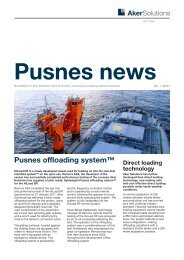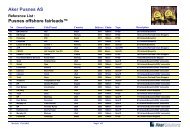Profile: Total's Daniel Picard Kristin: The First HPHT ... - Aker Solutions
Profile: Total's Daniel Picard Kristin: The First HPHT ... - Aker Solutions
Profile: Total's Daniel Picard Kristin: The First HPHT ... - Aker Solutions
You also want an ePaper? Increase the reach of your titles
YUMPU automatically turns print PDFs into web optimized ePapers that Google loves.
Compact areas are no obstacle.<strong>Kristin</strong>’s deck scope covers a utility and aprocess module. Both had to be built in 13months. A 12,300-ton deck for the Kvitebjørnplatform was built in 18 months and a 13,300-ton deck in 20 months for the Njord platform.Much of the fabrication, outfitting anddeck construction took place inside the hugemobile assembly hall at <strong>Aker</strong> Stord. Part of thedry-dock at Stord was rock-filled and theassembly hall was located in this area wheremodule assembly took place. Once that rockmaterial is removed, it allows a barge to float indirectly under the completed platform andcarry it out for hull mating. “We had to givemore attention to crane capacity because therewere so many big lifts so close together and thatis an HSE challenge,” he recalls. Lifts were limitedto a maximum 360 tons – the capacity ofthe Goliath crane at Stord.SuccessOne of the important factors in <strong>Kristin</strong> wasStatoil’s early identification of long lead equipmentpackages before contract award, the use offrame agreements and continuous material simulationsays Odd Olav Eide, <strong>Aker</strong> Kvaerner’sProcurement Manager for <strong>Kristin</strong>. Furthermore,he points out that some of the exotic pipingmaterial used had lead delivery times up to sixmonths ahead.Templates to subsea installation.<strong>Aker</strong> Kvaerner’s EPCH contract for <strong>Kristin</strong>involved ordering all required material; the onlyexception was the structural steel required for thehull built by Samsung in South Korea. <strong>The</strong>re wereapproximately 2,000 tons of piping materials andmore than 2,700 different articles. “We enteredinto discussions with European manufacturers atan early stage in order to reserve capacity.Consequently, when the exact material need wasidentified, the delivery could be called-off againstthe reserved capacity and the material deliveredat the sites on the necessary dates for construction.This required very good communicationwith the market and piping suppliers,” Eide says.Orders were placed for piping materials inquality carbon steel, stainless steel and exoticmaterials like titanium, duplex, 6Mo andsuperaustenetic. With superaustenetic, thereare only a few approved manufacturers inEurope. <strong>The</strong> lead-time for delivery was considerable,so requirements for superaustenetic hadto be predicted half a year ahead. As Eidestates, “It is a challenge to order material halfa year in advance.”Using <strong>Aker</strong> Kvaerner’s project executionmodel made it possible to identify early on thelate delivery of any items, and the potentialimpact on the <strong>Kristin</strong> schedule. “With integratedplanning, procurement, fabrication and completion,all relevant information is made availableimmediately, and that is a very important tool tobe able to manage all the logistical activities.”Delivery<strong>Kristin</strong>’s Engineering Manager Stefan Johansson’srole is to deliver topsides which can function asrequired for the field characteristics. Again, usingthe project execution model and with close cooperationwith construction crews from the verybeginning, his team has delivered all the necessarydrawings to the involved fabrication sites intime and with the right quality. But he is underconstant pressure to monitor platform weight – tominimize cost – while design changes have beenimposed. Topsides facilities have to handle bothpressure and temperature at a level of 3,770 psi(260 bar) and 266˚F (130˚C) “That is still veryhigh,” Johansson notes. He says the platform productioncapacities, the water depth and the numberof riser slots were all major design factors.Weight“On the floater, weight and center of gravityhave always been limiting factors,” saysJohansson. During the FEED (front-end engineeringand design) stage, there was a constantdrive to reduce topsides weight – structuralsteel in the design accounts for up to 50 percentof platform weight – and the overall size of theplatform to keep costs down.AKER KVAERNER MAJOR DELIVERIES TO KRISTINSemi EPCHEngineering, procurement, construction and hook-up for thesemi. <strong>The</strong> contract covering design and fabrication of thedeck, process facilities and utilities – and all module hook up.Contract Value: $714 million (NOK 5 billion)<strong>The</strong>refore to reduce weight, steel platinghas been optimized, with 1 mm increments,using thinner plate where possible. Normallysteel plating would be more standardized, butthis would mean over-design in some areas andmore weight. “So the platform is very, veryoptimized to get the weight down,” he explains.Subsea TechnologyKvaerner Oilfield Products (KOP) has a majorrole in the technology development necessaryfor <strong>Kristin</strong> by qualifying all subsea equipment.<strong>The</strong> scope of supply covers 12 christmas trees –including one spare – and 12 wellheads, manifolds,templates, production control system,workover systems, intervention tools, umbilicals,terminations and connections.Hans-Arne Andersson from KOP is the<strong>Kristin</strong> Subsea Manager. “What makes <strong>Kristin</strong>different from anything the industry has deliveredbefore is the very high pressure and temperature.That means we have to qualify a largeamount of equipment for this specific project,”Andersson explains. More than 50 separateitems have to be tested and qualified for exposureto the wellstream. “<strong>The</strong>re is a significantqualification program that has been completed,”he said. “With this amount of qualifications,it has been a real struggle to keep theproject within a normal delivery schedule. Weare behind, but are confident that we will meetStatoil’s ultimate need date.”While exotic metals are being used, equipmentexposed to the high temperatures bothexpands and contracts. This metal movement,mainly due to high temperature, has to be overcometo ensure systems integrity. He explainsthat the reservoir pressure is lowered by subseachokes while flowlines are protected by ahigh integrity pressure protection system(HIPPS) which monitors pressure lines – andshuts them down if any design limits are closeto being exceeded.Some of the metals are exposed toextreme temperature ranges from minus 68˚F(20˚C) up to 338˚F (170˚C). “That is thebiggest challenge.” He continues, “<strong>The</strong>re is noother facility that has this high productivityand this combination of <strong>HPHT</strong>.” <strong>Kristin</strong> is theproof of the strength of <strong>Aker</strong> Kvaerner’s projectexecution model and construction methods,together with planning, procurement and informationmanagement methods and systemtools. It has proven how these systems canmanage and adapt to new situations as theyarise – and keep a project on track. <strong>The</strong> groupsays the <strong>Kristin</strong> gas production platform willbe delivered on time, March 25, 2005, and itwill become a reference project both for Statoiland <strong>Aker</strong> Kvaerner."Subsea EPCSubsea production equipment, including four templates,wellheads with christmas trees and control systems,umbilical and associated installation equipment.Contract Value: $142.8 million (NOK 1 billion)PLATFORM CONTRACT DISTRIBUTIONWeight (Tons)Size (Feet/Meters)FC Samsung, Korea Semi-submersible Hull 14,455 250 x 210 x 135/76 x 64 x 41FC – Dragados, Spain Riser Area + Flare 4,230 280 x 100 x 65/86 x 30 x 20EPC Emtunga, Sweden Living Quarters + Helideck 2,010 160 x 50 x 60/49 x 15 x 18EPCH <strong>Aker</strong> Stord, Oslo & Stord Process Area 6,475 265 x 95 x 75/81 x 29 x 23Utility Area 5,369 280 x 105 x 110/86 x 34 x 33AKER STORD SUB-CONTRACTINGTons & HoursAKER VERDAL Main Steel Utility Module 1,500 TonsKVÆRNER EGERSUND Structural Sections to Utility and Process Modules, 28 Units 1,500 TonsKVÆRNER ROSENBERG 3 Structural Sections 280 TonsSTORD OFFSHORE Aluminum 50 TonsSUNDE OFFSHORE INDUSTRI Structural Nodes 13 TonsMORSKA, (Poland) Structural Outfitting/Aluminum 330 TonsLUSTER MEKANISKE Prefab. Piping 35,000 Man-hoursKVÆRNER EGERSUND Prefab. Piping 35,000 Man-hours16 17


